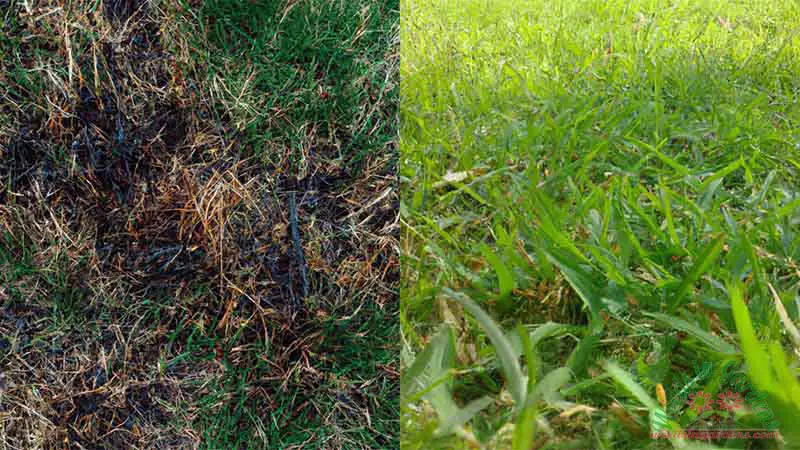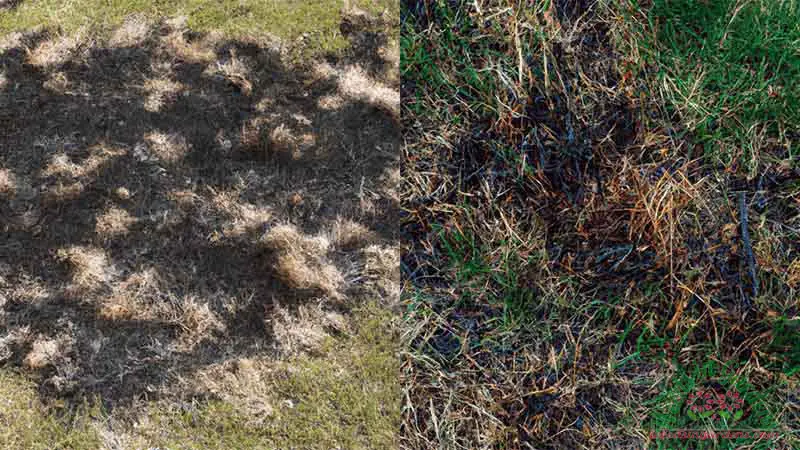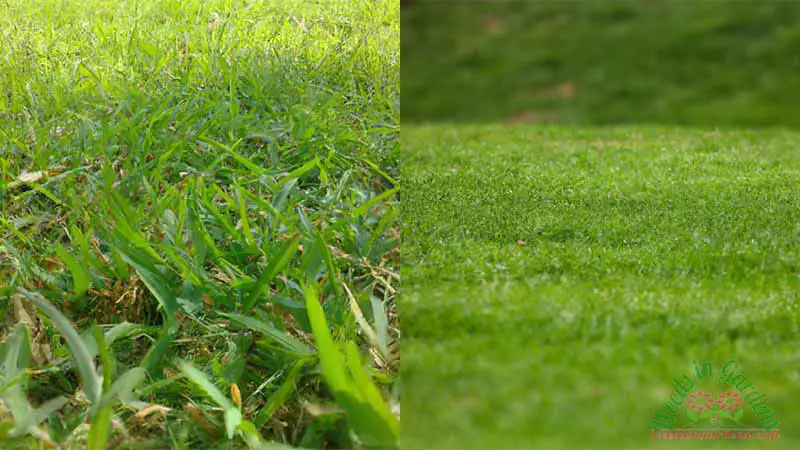Have you ever looked out at your lawn after a period of hot, dry weather, only to find it looking scorched and burnt? It’s a common problem for many homeowners, and it can be frustrating to see your once-lush lawn reduced to a patchy, brown mess. But don’t worry – burnt grass can recover, given the right conditions and a bit of patience. In this article, we’ll explore the question of how long it takes burnt grass to grow back, as well as what factors can affect the regrowth process.
First, let’s take a look at some of the causes of burnt grass. A few factors can contribute to grass becoming scorched or browned, including over-fertilization, drought, chemicals or pesticides, and heat or fire damage. Understanding what caused the damage in the first place can help you prevent it from happening again in the future.

Once you’ve identified the cause of the damage, it’s important to understand how grass recovers. Different types of grasses have different growth rates and requirements, and there are various factors that can affect how quickly and completely they recover from damage. We’ll delve into the stages of grass recovery, as well as the factors that can speed up or slow down the process.
Then, we’ll move on to the question of how long it takes for burnt grass to grow back. There are short-term and long-term recovery timelines to consider and various strategies that can help promote healthy regrowth. Following the right practices can help your lawn recover as quickly and effectively as possible.
So, whether you’re dealing with a small patch of scorched grass or a larger area of damage, this article is here to guide you through the process of getting your lawn back to its former green glory.
Causes of burnt grass

Grass is a resilient plant, but it can be vulnerable to damage from a variety of sources. Here are some of the most common causes of burnt grass:
- Over-fertilization
While fertilizer is essential for promoting healthy grass growth, it’s important to use it in moderation. Over-fertilizing can cause chemical burns, which can damage or kill grass. This is especially common if the fertilizer is applied too heavily or if it’s not watered in properly.
- Drought
Grass needs water to survive, and if it doesn’t get enough, it can become parched and dry. Drought can cause grass to turn brown and brittle, and if the dry conditions persist, the grass may die off completely.
- Chemicals and pesticides
Chemicals like herbicides and pesticides can be effective at controlling weeds and pests, but they can also damage grass if not used properly. This is especially true if the chemicals are applied at the wrong time or in the wrong amounts.
- Heat and fire
High temperatures and fires can scorch grass, causing it to turn brown or black. This can happen during periods of intense sunlight or during heat waves, as well as during wildfires or other outdoor fires.
Understanding the cause of the damage is key to preventing it from happening again in the future. By taking steps to avoid over-fertilizing, ensuring that your lawn gets enough water, using chemicals and pesticides sparingly and appropriately, and being cautious with fires, you can help protect your grass from damage. In the next section, we’ll look at how grass recovers from damage and what factors can affect the process.
Understanding grass recovery
Grass is a resilient plant, and it can recover from a variety of damage if given the right conditions and care. Here’s what you need to know about how grass recovers from damage:
A. Stages of grass recovery
Grass typically goes through three stages of recovery after being damaged:
- Survival: In the first stage, the grass focuses on survival. It may appear dormant or dead, but the roots are still alive and working to absorb water and nutrients from the soil.
- Regrowth: In the second stage, the grass begins to regrow. This may be slow at first, but as the roots become stronger and more established, new growth will become more noticeable.
- Recovery: In the final stage, the grass has fully recovered and is once again healthy and lush. This can take weeks, months, or even years, depending on the extent of the damage and the type of grass.
B. Factors that affect grass recovery
There are several factors that can affect how quickly and effectively grass recovers from damage. These include:
- Type of grass: Different types of grasses have different growth rates and requirements. Some types, like Bermuda grass, can recover relatively quickly from damage, while others, like fescue, may take longer.
- Severity of damage: The extent of the damage will also affect how long it takes for the grass to recover. A small patch of scorched grass may recover relatively quickly, while a large area of fire damage may take much longer.
- Climate and weather conditions: The climate and weather conditions in your area can also play a role in grass recovery. For example, if the weather is hot and dry, it may take longer for the grass to recover than if it’s cool and moist.
- Soil quality: Healthy soil is essential for promoting grass growth and recovery. If your soil is lacking in nutrients or is compacted, it may take longer for the grass to recover.
- Maintenance practices: Proper maintenance practices, like watering, fertilizing, and mowing, can also affect grass recovery. If you’re not taking care of your lawn properly, it may take longer for the grass to recover from damage.
Understanding these factors can help you take the right steps to promote healthy grass regrowth. In the next section, we’ll explore the question of how long it takes for burnt grass to grow back and what you can do to speed up the process.
Timeline for grass regrowth
If you’re dealing with burnt grass, you’re probably wondering how long it will take for your lawn to recover. The timeline for grass regrowth can vary depending on a number of factors, but here’s a general outline of what you can expect:
A. Initial recovery period
In the first few days or weeks after the damage occurs, your grass will likely appear brown or yellow and may appear dead. However, even if the blades of grass are dead, the roots may still be alive and working to absorb water and nutrients from the soil. During this initial period, keeping the soil moist is important to encourage root growth and recovery.
B. Regrowth period
After the initial recovery period, the grass will begin to regrow. This may be slow at first, but as the roots become stronger and more established, new growth will become more noticeable. You may see small green shoots poking up through the brown or yellow grass, and over time, these shoots will become longer and thicker.
C. Recovery period
The final stage of grass regrowth is the recovery period. This is when the grass has fully recovered and is once again healthy and lush. The length of the recovery period can vary depending on the severity of the damage and the type of grass, but it can take anywhere from several weeks to several months or even a year or more.
D. Factors that affect the timeline for grass regrowth
As we mentioned earlier, there are several factors that can affect how long it takes for burnt grass to grow back. These include:
- Severity of damage: The extent of the damage will have the greatest impact on how long it takes for the grass to recover. A small patch of burnt grass may recover relatively quickly, while a large area of damage may take much longer.
- Type of grass: Different types of grasses have different growth rates and requirements. Some types, like Bermuda grass, can recover relatively quickly from damage, while others, like fescue, may take longer.
- Climate and weather conditions: The climate and weather conditions in your area can also play a role in grass regrowth. If the weather is hot and dry, for example, it may take longer for the grass to recover than if it’s cool and moist.
- Soil quality: Healthy soil is essential for promoting grass growth and recovery. If your soil is lacking in nutrients or is compacted, it may take longer for the grass to recover.
E. Steps you can take to speed up the regrowth process
While the timeline for grass regrowth can vary, there are some steps you can take to help speed up the process. Here are a few tips:
- Water your lawn: Watering your lawn regularly is essential for promoting healthy grass growth. Make sure to water deeply and infrequently, rather than lightly and frequently, to encourage deep root growth.
- Fertilize your lawn: Fertilizing your lawn can help promote healthy growth and recovery. Choose a fertilizer that’s appropriate for your type of grass and apply it according to the instructions.
- Mow your lawn: Mowing your lawn regularly can help promote healthy growth and recovery. Make sure to keep your mower blades sharp and adjust the cutting height based on the type of grass you have.
- Aerate your lawn: Aerating your lawn can help improve soil quality and promote healthy root growth. Consider hiring a professional to aerate your lawn if you’re not comfortable doing it yourself.
By following these tips and taking care of your lawn properly, you can help promote healthy grass growth and speed.

Strategies for promoting grass regrowth
If you’re dealing with burnt grass, there are several strategies you can use to promote regrowth and help your lawn recover more quickly. Here are a few strategies to consider:
A. Reseeding
Reseeding is the process of planting new grass seed in areas where your lawn has been damaged. This can be a great way to promote regrowth and help your lawn recover more quickly. When reseeding, choosing a grass seed appropriate for your climate and soil conditions is important. You’ll also need to prepare the soil by removing any dead grass or debris, loosening the soil, and adding fertilizer if necessary.
B. Over-seeding
Over-seeding is similar to reseeding, but instead of planting new grass seed in bare areas, you’re planting it over the entire lawn. This can help promote healthy growth and recovery, especially if your lawn is thin or patchy in areas. When over-seeding, it’s important to choose a grass seed that’s appropriate for your climate and soil conditions, and to make sure that the new seed is able to germinate and establish itself before the weather turns too cold or too hot.
C. Aerating
Aerating is the process of creating small holes in your lawn to help improve soil quality and promote healthy root growth. This can be especially helpful if your soil is compacted or lacking in nutrients. When aerating, it’s important to use a machine or tool that’s appropriate for your lawn, and to make sure that the holes are spaced evenly and deep enough to allow air, water, and nutrients to penetrate the soil.
D. Fertilizing
Fertilizing your lawn can help promote healthy growth and recovery. When choosing a fertilizer, make sure to choose one that’s appropriate for your type of grass and soil conditions. It’s also important to follow the instructions carefully and not to over-fertilize, as this can cause more harm than good.
E. Watering
Watering your lawn is essential for promoting healthy growth and recovery. Make sure to water deeply and infrequently, rather than lightly and frequently, to encourage deep root growth. It’s also important to water at the right time of day and to avoid watering during the hottest part of the day, as this can cause the water to evaporate before it has a chance to penetrate the soil.
F. Mowing
Mowing your lawn regularly can help promote healthy growth and recovery. Make sure to keep your mower blades sharp and adjust the cutting height based on the type of grass you have. It’s also important not to cut your grass too short, as this can stress the grass and make it more vulnerable to damage.
Using these strategies and taking care of your lawn properly can help promote healthy grass growth and speed up the recovery process after your lawn has been damaged by fire or other causes.
Conclusion
In conclusion, burnt grass can be a frustrating problem for homeowners and can take some time to fully recover. However, with a bit of patience and the right strategies, you can help promote healthy grass regrowth and get your lawn looking green and lush once again.
First, it’s important to understand the causes of burnt grass, which can include anything from extreme heat and drought to chemical damage and fire. Once you understand what caused the damage, you can better address the issue and take steps to prevent it from happening again in the future.
Next, it’s important to understand the timeline for grass regrowth, which can vary depending on the severity of the damage and the type of grass you have. Generally, you can expect to see new growth within a few weeks to a few months, but it may take several months or even a year for your lawn to fully recover.
To promote grass regrowth, there are several strategies you can use, including reseeding, over-seeding, aerating, fertilizing, watering, and mowing. By choosing the right strategy for your lawn and following proper lawn care techniques, you can help encourage healthy growth and speed up the recovery process.
In summary, burnt grass may seem like a daunting problem, but with the right strategies and a bit of patience, you can help your lawn recover and thrive once again. By taking care of your lawn properly, you can prevent future damage and enjoy a beautiful, healthy lawn for years to come.
